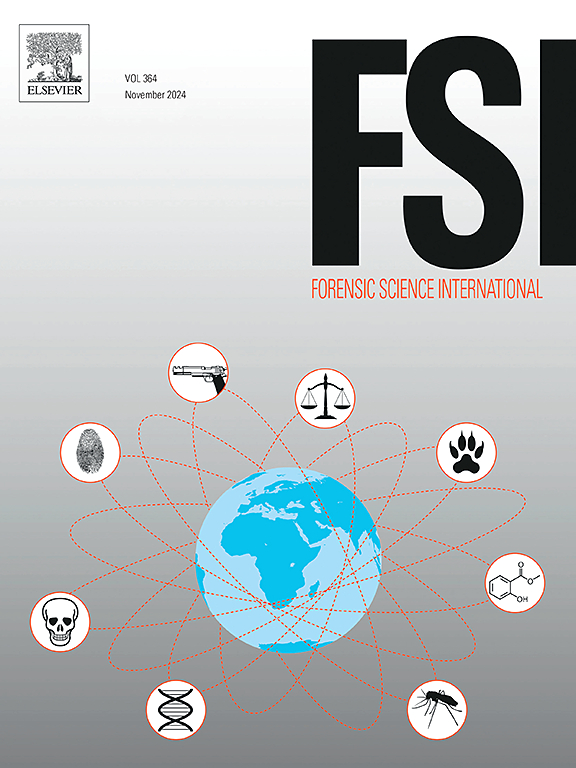研究3-CMC代谢:来自肝微粒体和死后生物基质的见解。
IF 2.2
3区 医学
Q1 MEDICINE, LEGAL
引用次数: 0
摘要
3-氯甲基卡西酮(3-CMC)是一种合成卡西酮,已被欧洲药物和药物成瘾监测中心确定为新型精神活性物质(NPS)。尽管自2014年以来,3-CMC在娱乐性药物市场日益流行,但有关3-CMC的科学文献仍然有限。本研究采用多步骤方法研究3-CMC代谢。首先,进行了一项计算机预测,以编制潜在代谢物的清单。然后,用人肝微粒体在两种浓度的3-CMC下进行体外检测。样品采用高分辨率质谱联用的高效液相色谱系统进行分析。采用Acquity UPLC HSS C18 1.8 µm, 2.1 × 150 mm色谱柱,Ultimate 3000系统色谱联用QExactivePlus质谱仪进行色谱分离。最后,使用Compound Discoverer软件进行代谢物鉴定的数据挖掘。通过计算机和体外结合的方法,在HLM实验中鉴定出3-CMC的四个主要代谢物:1)脂肪族羟基化得到M1; 2)随后减少β-酮族,得到M4;3) n -去甲基化,产生M2;4)还原β-酮基团,生成M3。随后对两例死后生物样本的分析显示,尿液是检测3-CMC及其代谢物的最具信息量的基质。M3代谢物被鉴定为人类肝微粒体中第三丰富的代谢物,但在人类死后样本中被鉴定为主要代谢物。识别这些关键代谢物对于提高法医调查的准确性和将检测窗口扩展到母体化合物之外至关重要。本文章由计算机程序翻译,如有差异,请以英文原文为准。
Investigating 3-CMC metabolism: Insights from liver microsomes and postmortem biological matrix
3-Chloromethcathinone (3-CMC) is a synthetic cathinone that has been identified as a new psychoactive substance (NPS) by the European Monitoring Centre for Drugs and Drug Addiction. Despite its increasing prevalence in the recreational drug market since 2014, scientific literature on 3-CMC remains limited.
This study employed a multi-step approach to investigate 3-CMC metabolism. First, an in-silico prediction was conducted to compile a list of potential metabolites. Then, in vitro assays were performed using human liver microsomes at two concentrations of 3-CMC. Samples were analyzed using an ultra-performance liquid chromatography system coupled with a high-resolution mass spectrometer. Chromatographic separation was obtained with an Acquity UPLC HSS C18 1.8 µm, 2.1 × 150 mm column on an Ultimate 3000 system chromatography coupled with a QExactivePlus mass spectrometer). Finally, data mining for metabolite identification was conducted using Compound Discoverer software.
The combined in silico and in vitro approaches identified four primary metabolites of 3-CMC in HLM assays:1) hydroxylation of the aliphatic group to give M1 2) followed by reduction of the β-keto group, yielding M4; 3) N-demethylation, affording M2; and 4) Reduction of the β-keto group, yielding M3.
Subsequent analysis of biological samples from two postmortem cases revealed that urine was the most informative matrix for detecting 3-CMC and its metabolites. The M3 metabolite, was identified as the third abundant metabolite in human liver microsome but was identified as the predominant metabolite in human postmortem samples. Identifying these key metabolites is crucial for improving the accuracy of forensic investigations and extending the detection window beyond the parent compound.
求助全文
通过发布文献求助,成功后即可免费获取论文全文。
去求助
来源期刊

Forensic science international
医学-医学:法
CiteScore
5.00
自引率
9.10%
发文量
285
审稿时长
49 days
期刊介绍:
Forensic Science International is the flagship journal in the prestigious Forensic Science International family, publishing the most innovative, cutting-edge, and influential contributions across the forensic sciences. Fields include: forensic pathology and histochemistry, chemistry, biochemistry and toxicology, biology, serology, odontology, psychiatry, anthropology, digital forensics, the physical sciences, firearms, and document examination, as well as investigations of value to public health in its broadest sense, and the important marginal area where science and medicine interact with the law.
The journal publishes:
Case Reports
Commentaries
Letters to the Editor
Original Research Papers (Regular Papers)
Rapid Communications
Review Articles
Technical Notes.
 求助内容:
求助内容: 应助结果提醒方式:
应助结果提醒方式:


